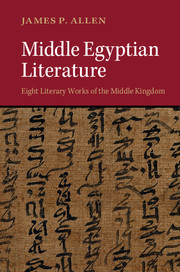Book contents
- Frontmatter
- Contents
- Introduction
- Text 1 The Story of the Shipwrecked Sailor
- Text 2 The Story of Sinuhe
- Text 3 The Loyalist Instruction
- Text 4 The Instructions of Kagemni's Father and Ptahhotep
- Text 5 The Discourses of the Eloquent Peasant
- Text 6 The Debate between a Man and His Soul
- Text 7 The Herdsman's Tale
- Text 8 Hymns to Senwosret III
- Consecutive Translations
Text 8 - Hymns to Senwosret III
Published online by Cambridge University Press: 05 January 2015
- Frontmatter
- Contents
- Introduction
- Text 1 The Story of the Shipwrecked Sailor
- Text 2 The Story of Sinuhe
- Text 3 The Loyalist Instruction
- Text 4 The Instructions of Kagemni's Father and Ptahhotep
- Text 5 The Discourses of the Eloquent Peasant
- Text 6 The Debate between a Man and His Soul
- Text 7 The Herdsman's Tale
- Text 8 Hymns to Senwosret III
- Consecutive Translations
Summary
Unlike the previous seven texts, hymns are literature composed for a purpose outside that of their own existence. In this case, the purpose is to honor the pharaoh Senwosret III of Dyn. XII (ca. 1878–1840 BC). Because the hymns refer to his “taking possession of the Two Lands” and do not mention the Nubian policy for which he became famous (including the string of forts in the Sudan), it is likely that the occasion was his accession to the throne.
The six hymns of this text are inscribed on a single papyrus now in the museum of University College, London (pUC 32157: Griffith 1898, pls. 1—3; Collier and Quirke 2004, 16—19, pls. 1—2), part of an archive found in the workers' village at Illahun. While other literary compositions are written as continuous text, all but the first of these hymns are laid out on the papyrus in discrete lines, similar to the arrangement of modern poetry. This feature indicates that the papyrus was the libretto for an actual ceremony, and is therefore contemporary with the reign of Senwosret III, probably the beginning of his first regnal year (ca. 1878 BC), rather than an archival copy.
The papyrus preserves six hymns, inscribed on three pages. The first of these contains what is probably an overall title (1, 1) followed by Hymn 1, which praises the king for the safety he brings to Egypt. Page 2 contains a song of rejoicing addressed to the king (Hymn 2: 2, 1—10) and another song of praise (Hymn 3: 2, 11—20). On Page 3 is a song celebrating the king's arrival (Hymn 4: 3, 1—10), and two short hymns that are only partially preserved (Hymn 5: 3, 11—4; Hymn 6: 3, 15—20), the first of which is addressed to the gods.
The verso of the papyrus contains the end of a story in a different hand, indicating that the papyrus was reused sometime after being inscribed with the hymns. Since the beginning of the story was to the right of the preserved part of the verso, the recto may have continued more hymns to the left, now lost.
- Type
- Chapter
- Information
- Middle Egyptian LiteratureEight Literary Works of the Middle Kingdom, pp. 369 - 382Publisher: Cambridge University PressPrint publication year: 2014

